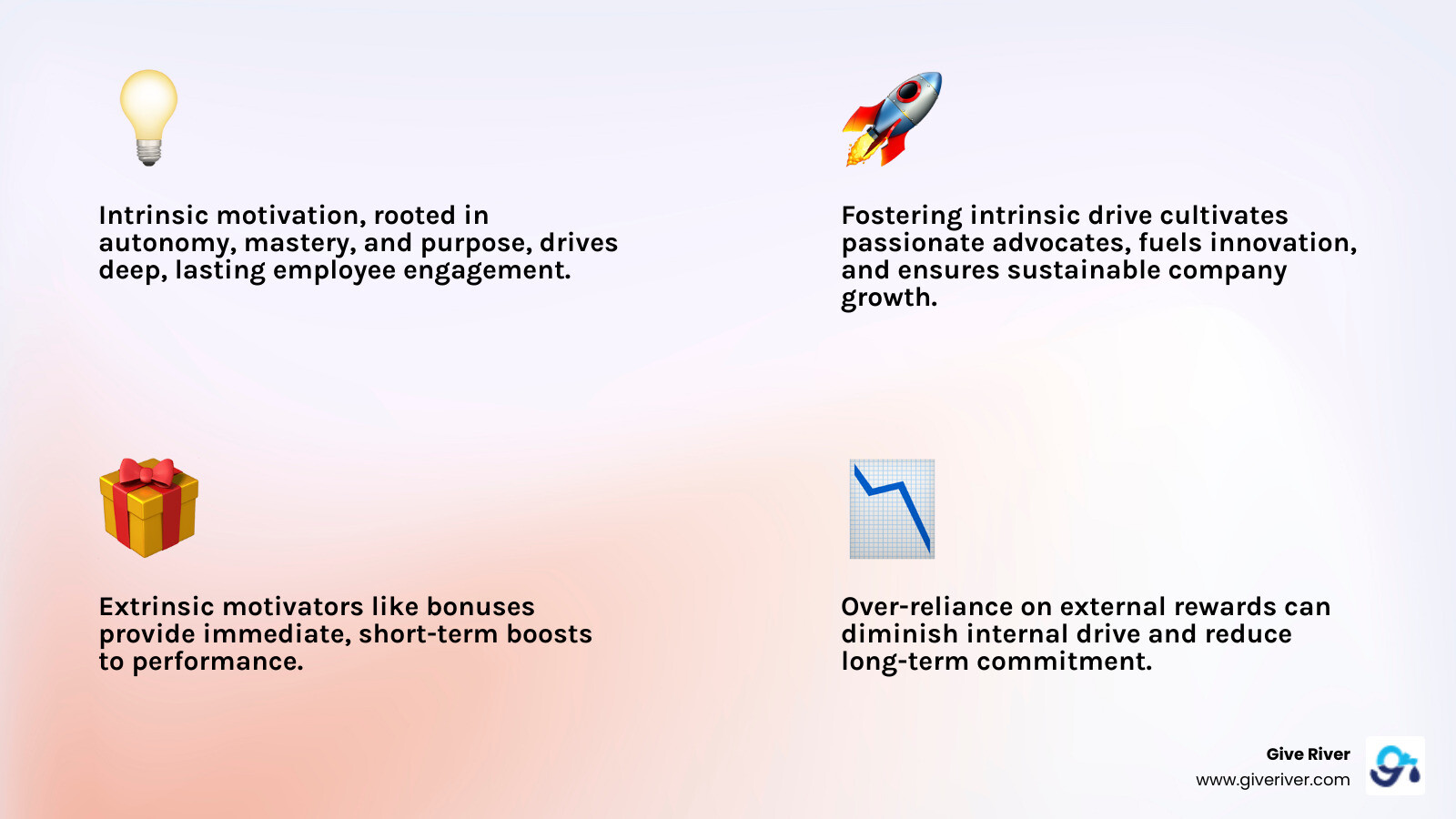Mojo Makers: How to Boost Employee Motivation (with or without a platform!)
Unlock effective staff motivation techniques to boost engagement & productivity. Foster intrinsic drive, recognition, & a positive culture.

Why Employee Motivation is Your Business's Superpower
Staff motivation techniques are the secret weapons that transform ordinary workplaces into thriving, high-performance environments. Here are the most effective approaches that actually work:
Core Staff Motivation Techniques:
- Autonomy & Flexibility - Give employees control over their work and schedules
- Recognition & Appreciation - Acknowledge achievements publicly and specifically
- Clear Goals & Purpose - Connect individual work to meaningful company mission
- Growth Opportunities - Provide learning, development, and advancement paths
- Positive Work Environment - Foster trust, respect, and psychological safety
- Fair Compensation - Ensure competitive pay aligned with performance
- Regular Feedback - Offer constructive, timely guidance and support
The stakes couldn't be higher. Gallup data reveals that only 34% of US workers are engaged at their jobs, with disengagement costing businesses between $450-550 billion annually. When employees are more excited to leave at the end of the day than they are to arrive in the morning, you're facing a motivation crisis.
But here's the good news: motivation isn't magic—it's science. Research consistently shows that while extrinsic motivators like bonuses provide short-term boosts, intrinsic motivators like autonomy, mastery, and purpose create lasting engagement. The companies that master both approaches don't just retain talent; they cultivate passionate advocates who drive innovation and growth.
While platforms like Bonusly and Kudos offer excellent tools for peer recognition, they only solve part of the puzzle. Give River provides a more holistic solution by integrating recognition with growth opportunities, wellness, and purpose. This comprehensive approach is designed to build sustainable motivation that goes beyond temporary rewards.
I'm Meghan Calhoun, and I've spent over two decades finding what truly drives people in high-pressure environments—from television production to sales roles that demanded peak performance. Through my work developing staff motivation techniques across diverse industries, I've learned that sustainable motivation comes from understanding the unique blend of intrinsic and extrinsic factors that energize each individual and team.

Staff motivation techniques terms simplified:
Core Staff Motivation Techniques for Lasting Impact
Understanding staff motivation techniques starts with recognizing what truly drives people at work. Think of motivation as the spark that transforms a job from something you have to do into something you want to do. It's the difference between watching the clock and losing track of time because you're so engaged.
The science is clear: there are two distinct types of motivation at play in every workplace. Intrinsic motivation comes from within—it's that satisfying feeling when you solve a challenging problem or master a new skill. Extrinsic motivation relies on external rewards like bonuses or recognition. While both have their place, research consistently shows that intrinsic motivation creates the lasting engagement that drives real performance.
Here's where it gets interesting: while platforms like Bonusly and Kudos focus primarily on external recognition systems, the most effective staff motivation techniques tap into deeper psychological needs. According to Self-Determination Theory, people thrive when they experience autonomy, mastery, and purpose in their work.
The goal isn't to choose between intrinsic and extrinsic motivation—it's to create an environment where both can flourish naturally, with intrinsic drivers forming the foundation for long-term satisfaction and performance.
Fuel Intrinsic Drive with Autonomy, Mastery, and Purpose
The most powerful staff motivation techniques work because they address three fundamental human needs that drive us from within. When you get these right, motivation becomes self-sustaining rather than something you constantly have to manufacture.
Autonomy transforms how people feel about their work. When employees have control over their schedules, decision-making, and work environment, something magical happens—they take ownership. A Forbes study found that 46% of job seekers now consider flexibility the most important factor when choosing a role. This isn't just about remote work; it's about trusting people to manage their responsibilities in ways that work best for them.
Autonomy might look like letting your marketing team choose their own project deadlines, allowing customer service reps to resolve issues without multiple approvals, or giving employees flexibility in how they structure their workday. When you demonstrate this level of trust, employees respond with increased confidence and commitment.
Mastery feeds our natural desire to grow and improve. People are wired to seek challenges that stretch their abilities just enough to feel accomplished without becoming overwhelming. Pew Research found that lack of advancement opportunities was among the top reasons workers quit their jobs last year, highlighting how crucial growth feels to today's workforce.
Career development programs work because they give people something to work toward beyond their next paycheck. This might mean assigning stretch projects that require new skills, providing mentorship opportunities, or simply helping employees see how their daily tasks are building expertise they can use throughout their careers.
Purpose connects individual work to something meaningful. When employees understand how their role contributes to the company's mission—and why that mission matters—their work takes on deeper significance. This doesn't require grand gestures; sometimes it's as simple as sharing customer success stories that show the real-world impact of your team's efforts.
The most effective leaders regularly communicate how individual contributions fit into the bigger picture, whether that's helping customers solve problems, supporting teammates' success, or contributing to community impact initiatives.
Build a Powerful Culture of Recognition: A Key Staff Motivation Technique
Recognition might seem straightforward, but there's real science behind why it works so powerfully as one of our core staff motivation techniques. When Gallup and Workhuman studied recognition that truly "hits the mark," they found employees were four times more likely to stay engaged and 73% less likely to experience burnout.
The key is moving beyond generic praise to recognition that feels genuine and specific. Instead of "great job on that project," try "I noticed how you took initiative to research three different solutions and presented clear pros and cons for each. That thoroughness saved us from potential problems down the road."
Timing matters just as much as specificity. The closer recognition comes to the achievement, the stronger the connection between effort and appreciation. This is where peer-to-peer recognition becomes incredibly valuable—colleagues often witness great work and can acknowledge it immediately.
While some employees thrive on public recognition during team meetings, others prefer a quiet conversation or handwritten note. Understanding these individual preferences transforms recognition from a one-size-fits-all program into a personalized experience that truly motivates each person.
The most effective recognition connects individual efforts to their impact on the team or company. When you share how someone's work contributed to a successful client outcome or helped a colleague meet their deadline, you're reinforcing both their value and their sense of purpose.
Unlike recognition-focused platforms like Kudos that primarily facilitate appreciation, Give River's approach integrates recognition into a broader ecosystem. Our 5G Method combines recognition with guidance, wellness, growth opportunities, gamification, and community impact—because sustainable motivation requires more than just saying "thank you."
Cultivate a High-Trust, Positive Work Environment
Creating a positive work environment isn't about ping pong tables or free snacks—it's about building the psychological foundation that allows all other staff motivation techniques to flourish. When employees feel safe, respected, and valued, they're naturally more motivated to contribute their best work.
Trust forms the bedrock of motivation. Research reveals that people at high-trust companies experience 74% less stress, 106% more energy at work, and 50% higher productivity compared to low-trust environments. But trust isn't built through grand gestures; it's earned through consistent, transparent communication and follow-through on commitments.
This means being honest about company challenges, sharing relevant updates about projects and financial health, and admitting when you don't have all the answers. A BlessingWhite Research study found that 20% of workers—including nearly a third of disengaged employees—said "greater clarity about what the organization needs me to do and why" would most improve their performance.
Psychological safety enables innovation and growth. When people feel comfortable admitting mistakes, asking questions, and proposing new ideas without fear of punishment, they become more creative and collaborative. This environment encourages the kind of risk-taking and learning that drives both individual growth and company innovation.
Respectful communication plays a crucial role here. Recent polling of over 1,000 early-career professionals found that respectful communication ranked higher than traditional workplace perks. This means practicing active listening, providing constructive feedback, and treating every team member's input as valuable.
Connection strengthens motivation. Team building activities work because they help people see their colleagues as whole individuals rather than just job titles. Whether it's a problem-solving challenge, a virtual coffee chat, or a volunteer project, these shared experiences build the relationships that make work more enjoyable and collaborative.

Identify and Eliminate Common Motivation Killers
Even the best staff motivation techniques can't overcome certain workplace toxins that actively drain employee energy and enthusiasm. Identifying and eliminating these motivation killers is just as important as implementing positive strategies.
Micromanagement destroys the autonomy that drives intrinsic motivation. When employees feel constantly watched and second-guessed, they stop taking initiative and start simply following orders. The Pew Research Center found that feeling disrespected—which often manifests as micromanagement—was a leading reason people quit their jobs.
Unfairness in performance reviews and advancement opportunities creates deep resentment. Only 26% of North American companies report having effective performance management systems, and about one-third say employees feel fairly evaluated. When people perceive reviews as inconsistent or biased, it undermines their motivation to excel. Research shows that employee engagement increases by 14 points when workers view their performance reviews as fair.
Lack of clarity about expectations and goals leaves people feeling frustrated and directionless. If employees don't understand what success looks like or how their work contributes to larger objectives, they can't feel the satisfaction that comes from meaningful achievement.
The most effective approach to eliminating motivation killers involves understanding individual personalities and triggers. Some employees thrive on direct feedback, while others need more gentle guidance. Some are energized by public recognition, while others prefer private acknowledgment. Regular one-on-one conversations help managers identify what specifically motivates each person and what tends to discourage them.
Measuring the impact of your motivation strategies ensures you're actually solving problems rather than just implementing programs. Track engagement through regular surveys, monitor retention rates and absenteeism patterns, and conduct thoughtful exit interviews to identify recurring issues. Employee engagement and motivation research shows that companies capable of tapping into diverse motivational factors experience lower turnover, higher productivity, and improved profitability.
By actively addressing these demotivating factors while building positive systems for recognition, autonomy, and growth, you create an environment where motivation can truly thrive. This comprehensive approach ensures you're not just patching problems, but building a foundation for sustained engagement and performance.
Conclusion: Turn Motivation into Momentum
The journey through staff motivation techniques reveals a fundamental truth: motivation isn't just about making people feel good—it's about releaseing the full potential of your organization. When we understand that engagement statistics showing only 34% of workers feeling connected to their work, we realize we're not just facing an HR challenge; we're looking at the biggest untapped opportunity in modern business.
Throughout this exploration, we've finded that the most powerful motivation comes from within. Autonomy, mastery, and purpose aren't just buzzwords—they're the three pillars that transform employees from clock-watchers into passionate contributors. When people feel trusted to make decisions, challenged to grow their skills, and connected to meaningful work, something remarkable happens. They stop working for you and start working with you.
The culture of recognition we've discussed goes far beyond the occasional "employee of the month" plaque. Specific, timely appreciation creates ripple effects that reduce burnout by 73% and multiply engagement by four. But here's what makes the difference: recognition must feel authentic, not automated. While platforms like Bonusly and Kudos offer solid recognition tools, the real magic happens when appreciation becomes woven into the fabric of daily interactions.
Building trust and psychological safety isn't soft leadership—it's strategic leadership. Those high-trust companies we mentioned? They don't just see 76% more engagement by accident. They've created environments where people feel safe to innovate, make mistakes, and grow. This kind of culture becomes your competitive advantage in attracting and retaining top talent.
Perhaps most importantly, we've learned to spot and eliminate the motivation killers that silently drain energy from our teams. Micromanagement, unclear expectations, and feeling undervalued don't just hurt individual performance—they create a downward spiral that affects entire organizations.
At Give River, we've seen how our 5G Method transforms workplaces by addressing all these elements simultaneously. Our approach integrates recognition, guidance, personal wellness, professional growth content, gamification, and community impact because we understand that motivation isn't one-dimensional. When employees feel appreciated, supported in their growth, and connected to something larger than themselves, they don't just stay—they thrive.
The path forward is clear. Start with one technique that resonates most with your team's current needs. Maybe it's implementing more specific recognition practices, or perhaps it's giving people more autonomy in their daily work. The key is consistency and genuine commitment to seeing your people succeed.
Every day your employees choose to bring their best selves to work—or not. These staff motivation techniques help tip that choice in favor of engagement, fulfillment, and shared success. When you get this right, you're not just improving workplace culture; you're building the foundation for sustainable growth and innovation.
Boost your team's morale with an Employee Recognition Platform






